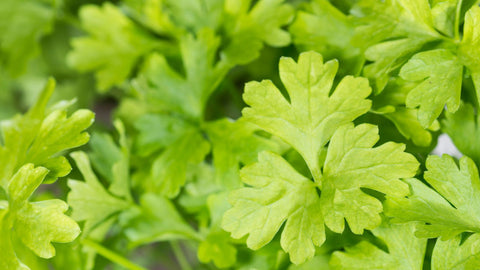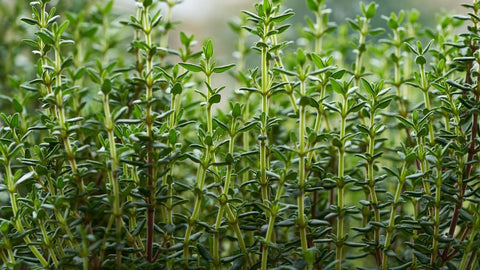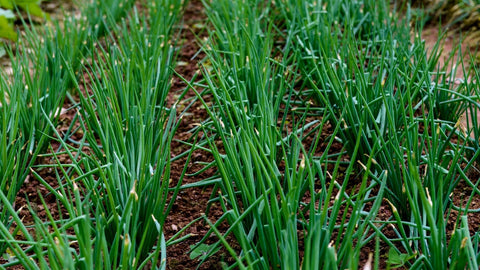Parsley is a pretty universal herb - adding a burst of flavor to your soups, salads, and pasta, and sauces. You can even add it to your dog’s food to freshen your pup's breath! In this blog, we’ll cover everything you need to know to successfully grow parsley outdoors - from basic facts, supplies, setup, and steps to grow, care for and harvest it, and gardening zones in the US and how they can impact outdoor gardening.
|
Plant type |
Biennial |
|
Family |
Apiaceae |
|
Binomial name |
Petroselinum crispum |

Timing
Parsley sprouts in 2-4 weeks and can be harvested from Month 3+ on.

Part sun
Parsley needs an equivalent of 4+ hours of direct sun [DLI of 12+ mol/m²/day] so it can grow bountifully.

Care
Growing parsley outdoors is very beginner friendly, but it can involve a few more steps compared to growing it indoors. You’ll sprout, thin, prune, and harvest, and maybe try to get rid of pests and other problems from time to time.
TABLE OF CONTENTS
Ways to Grow Parsley | Care and Maintenance for Parsley | Timeline & Steps | Cultivars/Varieties
Ways to Grow Parsley Outdoors
Growing Parsley Outdoors Using Soil
To start growing parsley outdoors, you need to make sure that the parsley plants are planted in moist soil conditions. If the soil dries out completely the roots will die back and it will be tough for the plant to recover.
On the other hand, if the roots are exposed to standing water for too long, they can rot.
You have two options to choose from when growing parsley outdoors:
- plant directly onto soil, or
- use a container - with drainage!
If you prefer planting directly onto soil, you can use potting mixes you can buy from stores or online, or you can also create your own. In this blog, we explained how to create your own potting mix. Just remember that herbs such as parsley thrive more in nutrient-dense soils, so if you don’t have that, you can also look into incorporating plant foods or fertilizers.
We prefer using containers as we have more control over the growth of herbs by using this method. Some herbs can grow aggressively and take over the whole space of garden beds or soil sites. Take note that if you opt for containers, they should have good drainage as herbs such as parsley thrive well in this kind of environment.
If you’re not sure what size of pot or container to use for your herbs, check this out.
You can also see the table comparison below about the pros and cons of soil and containers:
|
Pros |
Cons |
|
|
Soil (in ground) |
|
|
|
Container |
|
|
Other Ways to Grow Parsley Outdoors
You can also use ollas (plant watering spikes/globes) for your containers to help with drainage. Raised beds are a good choice for growing herbs such as parsley outdoors, too.
Best Gardening Zones for Growing Parsley Outdoors
Parsley can be grown in most areas, but the most recommended zones are zones 3-9.
You can also check out how to grow parsley indoors if you’d like your parsley plants to be transplanted or grown indoors instead.
Care and Maintenance of Parsley Outdoors
Lighting for Growing Parsley Outdoors
Out of all edible plants, parsley plants have some of the lowest light needs. That said, we suggest planting them on a place that gets at least 4+ hours of direct sunshine a day for best results.
What is The Right Temperature for Your Indoor Parsley Plant?
Extend your harvest by keeping the temperatures cool
Parsley is known as a “cool weather crop.” If it senses warming temperatures it will “bolt” - send up flowers and become bitter in the process. Where you plant them can have some effect on the temperature - lower positions on a growing rack and ceramic planters tend to run cooler. It's best to avoid windows that get really hot (like bay windows)
Water and Humidity
Herbs such as parsley thrive on consistent moisture but can suffer if they’re waterlogged, so make sure to water them regularly especially if you’re using soil. To avoid your indoor parsley plant being waterlogged, make sure to use a pot with drainage, or you can also use ollas to help with drainage, as mentioned above.
Nutrients and Fertilizers
Parsley likes to start with nutrients that are equal parts nitrogen, phosphorus, and potassium (with NPK numbers like 10-10-10). For this Balanced Blend, we recommend: Dr Earth All Purpose.
Once they are growing, it’s better to use plant food that is high in nitrogen (with NPK numbers like 10-5-5). For this Herb Blend, we recommend: Joyful Dirt All Purpose
Moving Your Outdoor Parsley Plant Indoors
Parsley is a cool-weather crop, which can likely withstand being moved indoors when the weather gets too warm for its liking. To learn more about how to grow your parsley indoors, check this out.
Common Problems with Growing Parsley Outdoors
Pests
As you’ll be growing your parsley outdoors, you need to keep in mind that you might encounter pests such as armyworms, cutworms, aphids, beetles, and leafminers.
To learn more about managing these pest problems for parsley, check out this educational article from the University of Florida .
Diseases
Growing plants outdoors or outdoors can bring risks to your plants to also have diseases, such as crown root rot, blight, and leaf spots.
There are different solutions for each of these diseases and for you to know more about them, we suggest reading through this helpful article from gardeningknowhow.com.
Timeline and Steps on How to Grow Parsley Outdoors
Best Setup for Outdoor Parsley Plants
Below is the best setup (and a very easy one!) for growing your parsley outdoors. You’ll need:
Planter:
Ceramic Self Watering Planter (preferred) or pot that is at least 4" / 1 pint. Raised beds and ollas can are also great choices.
Soil:
Free-Draining Mix
Plant Food:
At the start: Balanced Blend. This should be equal parts nitrogen, phosphorus, and potassium (with NPK numbers like 10-10-10).
On going: Herb Blend. This should be high in nitrogen (with NPK numbers like 10-5-5).
Growing Parsley from Seed vs Cutting vs Nursery Plant Outdoors
New parsley plants can be started from seed, propagated from an established plant, or purchased live at many garden centers. We prefer to sprout from seed or propagate from a stem cutting, as it results in plants that are adapted to your growing conditions and limit the chances that you accidentally bring home pests.
How to Plant Parsley Seeds

Parsley grows quickly from seed. Plant 1 site in a 4" / 1-pint container. In larger containers, space sites 4" apart. For each site plant 2 seeds 1/4 inches deep. Keep the soil warm ( 40-90°F, ideally 70°F). Sprouts typically appear in 14 days but can be as quick as 7 days or as long as 21 days depending on your conditions. To speed things up, you can soak them in water for 12-24 hours before planting.
To speed things up, you can soak them in water for 12-24 hours before planting.
How to Transplant Parsley

Live starter plants give you a big jump start on your first harvest. When you’re in a garden center - pick the bushiest plant available (tall and lanky ones will be weak growers) and give it a good inspection for pests. Leaves should be dark green without holes, spots, or curled edges. A best practice is to actually “quarantine” your plant for about a week after bringing it home to make sure it's free and clear of ride-on pests.
Ensuring it’s pest and disease-free it’s time to transplant your seedling into its final home.
- Remove some soil from its final planter - leaving enough space for the bottom of the seedling to be just higher than the soil surface.
- Hold on to the base of the stem with one hand, and turn the pot over while gently pulling the seedling. Giving the pot a few squeezes can help dislodge it.
- Place in its final container and fill around it with soil so that it’s tight, but not compacted.
Week 2-4: Check for Sprouts
You could see seedlings in as little as 7 days (though 14 days is more typical). If it’s been 21 days and you still don’t have any sprouts, it’s likely that your setup is too cold.
Week 4: Thin Your Seedlings

Thin your planter to only have 1 seedling per site - leaving the largest plant. If you are using the recommended planter (at least 4" / 1 pint) this will mean you’ve got 1 plant after thinning. By getting rid of the smaller seedlings, you’re allowing the biggest and strongest one to flourish by reducing its competition for water, food, and space.
If your seedlings are under 1 inch, stretching out, or folding over, it’s likely that they don't have quite enough light.
Week 5: How to Prune Outdoor Parsley Plants

You’ll notice how all the stems and leaves of Parsley grow from a single, central point (called radial growth). The plant puts out new leaves in the center and pushes old leaves outward, getting bigger and bushier over time.
Pruning and harvesting are one-in-the-same as Parsley. Once the plant has at least 3 separate stems coming from the base, take one of the outside leaves and cut it close to the base (½” above is fine). It’s good to leave at least 2/3rds of the plant left to regrow. If you only want a tiny amount of herbs, you also can clip the top of an individual stem – just be sure to leave some leaves on that stem, otherwise it won’t grow back.
Month 3+: How to Harvest Parsley
Wait until the bottom leaves have at least 3 segments to harvest and always harvest the outer leaves, leaving the inner ones to mature.
How to Use Your Freshly-harvested Parsley in Cooking
Just like most herbs, parsley is also a common ingredient used by the most prominent chefs around the world to ordinary food lovers at home. Parsley leaves can be used in many ways:
- Blended/processed into dips/sauces
- Garnish/toppings on sandwiches, pizza, pasta, soups
- Blended into smoothies
Check out some more of our favorite parsley recipes here.
How to Preserve Parsley
There are several ways to preserve or keep your herbs such as parsley fresh, and here are just some of the easiest and the ones we recommend the most:
- Lazy person technique. It involves keeping the fresh herbs in their original packaging and simply storing them in the fridge.
- Storing the herbs in a glass of water inside the fridge. You can do this by cutting the end of the stem of your herb, filling a glass jar or cup with water, and placing your herb inside. Almost like a vase or bouquet of herbs!
- Keep in a glass of water under natural lighting.
- Wrap loosely in a damp paper towel.
- Freeze them herbs! Yes, you can freeze fresh herbs such as parsley, to use at a later time! All you need are some ice cube trays and a freezer, and you’re all set.
Learn more about how to preserve and keep your herbs and parsley fresh here.
Month 6+: End of Life
Parsley is a biennial plant which means it naturally sets seed when it experiences hot summer temperatures.
If you’d like to learn about the dozens of other herbs, fruits, and vegetables that you can grow indoors or outdoors then grab a copy of our free eBook below.
Growing Parsley Outdoors and the Best Varieties to Grow
To answer your question about “which parsley varieties should I grow outdoors”, the two major varieties of parsley are curly-leaf and flat-leaf. There are two other varieties, which are not as common and are used/cooked differently: Hamburg and Japanese parsley.
Below is a table showing each of their unique features. We also included the product links for your reference.
|
Variety |
Curly-leaf |
Flat-leaf (Italian) |
Hamburg |
Japanese |
|
Why We Like Them |
It’s mainly used in salads and for garnishing. It’s usually smaller in size than the rest with controlled growth. |
This is the most common variety of parsley used for cooking. It’s stronger, vibrant, and sweeter than the rest. |
It’s less common than the other two varieties, and it’s mainly grown for its edible, swollen parsnip-flavored roots that are used as vegetables. |
It is used as a seasoning, a potency tonic, and the leaves and roots are cooked as a vegetable while sprouts are eaten in salads. |
|
Purchase Link |
We hope that this blog has given you everything you need to know about growing parsley outdoors. In case you have any questions, just leave a comment below.











There are no comments for this article. Be the first one to leave a message!